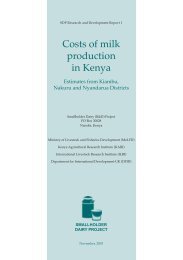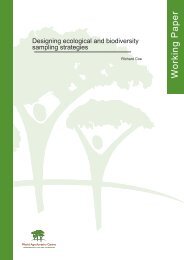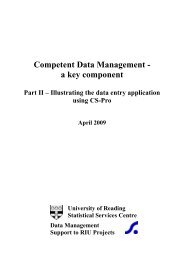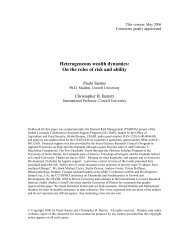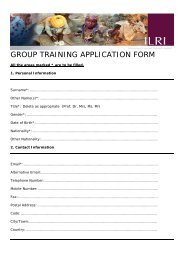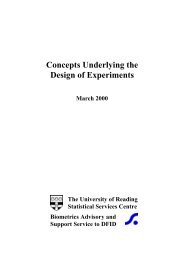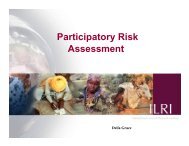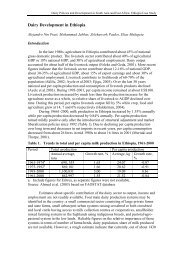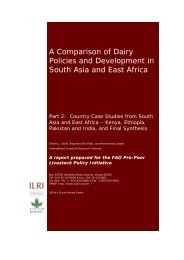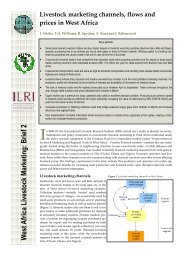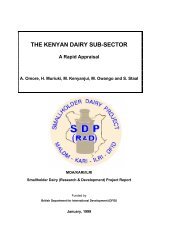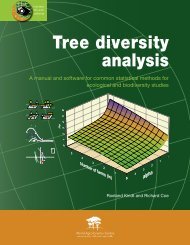Improvement of Livestock Production in Crop-Animal Systems in ...
Improvement of Livestock Production in Crop-Animal Systems in ...
Improvement of Livestock Production in Crop-Animal Systems in ...
Create successful ePaper yourself
Turn your PDF publications into a flip-book with our unique Google optimized e-Paper software.
Table 7.Ma<strong>in</strong> crop–animal <strong>in</strong>teractions <strong>in</strong> mixed farm<strong>in</strong>g systems.<strong>Crop</strong> production<strong>Crop</strong>s provide a range <strong>of</strong> residues and by-products thatcan be utilised by rum<strong>in</strong>ants and non-rum<strong>in</strong>ants.Native pastures, improved pastures and cover-cropsgrow<strong>in</strong>g under perennial tree crops can provide graz<strong>in</strong>gfor rum<strong>in</strong>ants.<strong>Crop</strong>p<strong>in</strong>g systems such as alley-cropp<strong>in</strong>g can providetree forage for rum<strong>in</strong>ants.<strong>Animal</strong> productionLarge rum<strong>in</strong>ants provide power for operations such asland preparation and for soil conservation practices.Both rum<strong>in</strong>ants and non-rum<strong>in</strong>ants provide manure forthe ma<strong>in</strong>tenance and improvement <strong>of</strong> soil fertility. Inmany farm<strong>in</strong>g systems it is the only source <strong>of</strong> nutrientsfor cropp<strong>in</strong>g. Manure can be applied to the land or, as <strong>in</strong>non-rum<strong>in</strong>ant systems <strong>in</strong> South-East Asia, to the waterwhich is applied to vegetables whose residues are thenused by non-rum<strong>in</strong>ants.The sale <strong>of</strong> animal products and the hir<strong>in</strong>g out <strong>of</strong> draftanimals can provide cash such as fertiliser and pesticidesused <strong>in</strong> crop production.<strong>Animal</strong>s graz<strong>in</strong>g vegetation under tree crops can controlweeds and reduce the use <strong>of</strong> herbicides <strong>in</strong> farm<strong>in</strong>gsystems.<strong>Animal</strong>s provide entry-po<strong>in</strong>ts for the <strong>in</strong>troduction <strong>of</strong>improved forages <strong>in</strong>to cropp<strong>in</strong>g systems. Herbaceousforages can be undersown <strong>in</strong> annual and perennial cropsand shrubs or trees established as hedgerows <strong>in</strong>agr<strong>of</strong>orestry-based cropp<strong>in</strong>g systems.<strong>Animal</strong> feeds from crops<strong>Crop</strong> production provides a range <strong>of</strong> residues and AIBP that can be utilised by rum<strong>in</strong>ants and non-rum<strong>in</strong>ants.These <strong>in</strong>clude cereal straws (e.g. rice and maize), sugar-cane tops, gra<strong>in</strong> legume haulms (e.g. peanut andcowpea) root crop tops and v<strong>in</strong>es (e.g. cassava and sweet potato), oilseed cakes and meals (e.g. oil palm kernelcake, cottonseed cake and copra cake), rice bran, p<strong>in</strong>eapple and citrus pulp, cocoa pod husks, c<strong>of</strong>fee seedpulp and bagasse.In Asia, rice straw is the pr<strong>in</strong>cipal fibrous residue fed to over 90% <strong>of</strong> the rum<strong>in</strong>ants. Devendra (1996b)has calculated that 30.4% <strong>of</strong> rice straw is used for feed <strong>in</strong> the ASEAN sub-region, the Mekong countries,Mongolia and Ch<strong>in</strong>a. In <strong>in</strong>dividual countries such as Thailand, the use <strong>of</strong> straw for animal feed is significantlyhigher. Wanapat (1990), for example, has calculated that 75% <strong>of</strong> rice straw from ra<strong>in</strong>fed upland farms and82% from lowland farms are collected for use as feed.Non-conventional feed resources (NCFR) are identified separately and <strong>in</strong>clude all those products thathave not been used traditionally <strong>in</strong> animal feed<strong>in</strong>g. These feeds are diverse and <strong>in</strong>clude palm oil mill effluentand rubber seed meal (Indonesia and Malaysia), cocoa pod husks (Malaysia), p<strong>in</strong>eapple waste (the Philipp<strong>in</strong>esand Malaysia), cassava pomace (Malaysia and Thailand), distiller solubles and poultry litter. It has beenestimated that the total availability <strong>of</strong> feed resources (other than grasses) from traditional and NCFR <strong>in</strong> theregion is 199 million tonnes, with NCFR form<strong>in</strong>g about 47% (Devendra 1992). Approximately 80% <strong>of</strong> thetotal feed available is potentially best suited for feed<strong>in</strong>g to rum<strong>in</strong>ants. However, it is also recognised thatsocio-economic factors are important <strong>in</strong> determ<strong>in</strong><strong>in</strong>g their use.Weed control<strong>Animal</strong>s graz<strong>in</strong>g vegetation under perennial tree crops such as rubber, oil-palm and coconut can control weedsand reduce the costs <strong>of</strong> herbicide use. In rubber, the cost <strong>of</strong> herbicides can be as much as 30% <strong>of</strong> the totalcost <strong>of</strong> production <strong>in</strong> the early years <strong>of</strong> the plantation. Most <strong>of</strong> the native vegetation <strong>of</strong> grasses, legumes andbroad-leaved plants (<strong>of</strong>ten 60–70% <strong>of</strong> floristic composition), found <strong>in</strong> the <strong>in</strong>ter-rows <strong>of</strong> rubber plantations,



